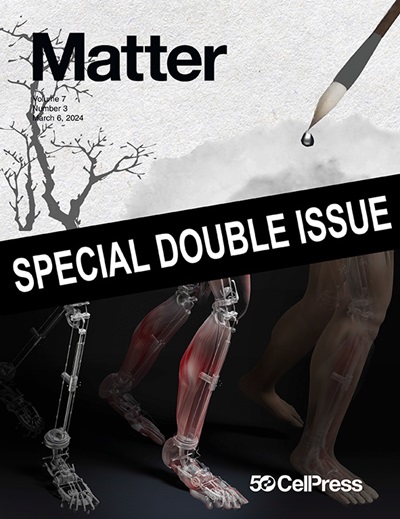通过陶瓷纳米线网络中的熔融金属约束减轻电极侵蚀
IF 17.5
1区 材料科学
Q1 MATERIALS SCIENCE, MULTIDISCIPLINARY
引用次数: 0
摘要
大电流开关中的金属电极承受强烈的热冲击(例如电弧放电),通过金属蒸发、熔融液滴飞溅和地下孔隙/裂纹形成等机制受到侵蚀。这会降低电接触质量,加剧腐蚀并加速过早失效。在这里,我们证明了结合陶瓷纳米线网络(如ZnO)有效地限制了熔融金属(如Ag),减轻了电极侵蚀,并提高了接触耐久性。与广泛研究的陶瓷纳米颗粒-金属复合材料不同,高纵横比纳米线很容易缠绕形成一个有凝聚力的3D网络,在固体和熔融状态下都能将金属固定在一起,保持复合材料的电气和机械性能以及结构完整性。该网络显著提高了熔融金属的粘度,抑制了流动、飞溅和地下孔隙/裂纹的形成。因此,在反复的电弧放电测试后,微结构稳定性的提高导致了持续的接触性能。本文章由计算机程序翻译,如有差异,请以英文原文为准。

Mitigating electrode erosion through molten metal confinement in ceramic nanowire networks
Metal electrodes in high-current switches endure intense thermal shocks (e.g., arc discharge), eroding through mechanisms such as metal evaporation, molten droplet splashing, and subsurface pore/crack formation. These degrade electrical contact quality, aggravating erosion and accelerating premature failure. Here, we demonstrate that incorporating ceramic nanowire networks (e.g., ZnO) effectively confines molten metal (e.g., Ag), mitigates electrode erosion, and enhances contact durability. Unlike extensively studied ceramic nanoparticle-metal composites, high-aspect-ratio nanowires readily entangle to form a cohesive 3D network, holding the metal together in both solid and molten states, maintaining the composite’s electrical and mechanical properties and structural integrity. The network significantly increases molten metal viscosity, suppressing flow, splashing, and subsurface pore/crack formation. Consequently, the improved microstructural stability results in sustained contact performance after repeated arc-discharge testing.
求助全文
通过发布文献求助,成功后即可免费获取论文全文。
去求助
来源期刊

Matter
MATERIALS SCIENCE, MULTIDISCIPLINARY-
CiteScore
26.30
自引率
2.60%
发文量
367
期刊介绍:
Matter, a monthly journal affiliated with Cell, spans the broad field of materials science from nano to macro levels,covering fundamentals to applications. Embracing groundbreaking technologies,it includes full-length research articles,reviews, perspectives,previews, opinions, personnel stories, and general editorial content.
Matter aims to be the primary resource for researchers in academia and industry, inspiring the next generation of materials scientists.
 求助内容:
求助内容: 应助结果提醒方式:
应助结果提醒方式:


